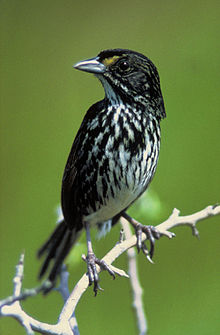Bird conservation
[1] According to Worldwatch Institute, many bird populations are currently declining worldwide, with 1,200 species facing extinction in the next century.
[3] Other threats include overhunting, accidental mortality due to structural collisions, long-line fishing bycatch, pollution,[4] competition and predation by pet cats,[5] oil spills and pesticide use and climate change.
[6] The loss of forests, plains and other natural systems into agriculture, mines, and urban developments, the draining of swamps and other wetlands, and logging reduce potential habitat for many species.
[7] The loss of tropical rainforest is the most pressing problem, as these forests hold the highest number of species yet are being destroyed quickly.
Habitat loss has been implicated in a number of extinctions, including the ivory-billed woodpecker (disputed because of "rediscovery"), Bachman's warbler and the dusky seaside sparrow.
Some of these were unfamiliar predators, like rats, feral cats, and pigs; others were competitors, such as other bird species, or herbivores that degraded breeding habitat.
Disease can also play a role; introduced avian malaria is thought to be a primary cause of many extinctions in Hawaii.
Overhunting occurred in some instances with a naive species unfamiliar with humans, such as the moa of New Zealand,[10] in other cases it was an industrial level of hunting that led to extinction.
Increasingly large volumes of plastic waste are being transported by wind and ocean currents throughout the planet, and mistaken ingestion by many species is eventually fatal.
[12] Seabirds are also vulnerable to oil spills, which destroy the plumage's waterproofing, causing the birds to drown or die of hypothermia.
[15] The use of pesticides continues to harm birds, especially insectivores like swallows that have lost a food source from the use of insecticides in agriculture.
[16] Seabirds face another threat in the form of bycatch, where birds in the water become tangled in fishing nets or hooked on lines set out by long-line fisheries.
Approximately 7,500 migrating songbirds were attracted to and killed by the flare at the liquefied natural gas terminal in Saint John, New Brunswick, Canada on September 13, 2013.
[21] The recent growth in the renewable energy industry is also increasing the threat to birds farther away from dense human population centers.
The primary impact of commercial solar farms – the majority utilizing photovoltaic collectors which are mounted near the ground – is from extensive land clearing and increases in long-distance power transmission infrastructure.
In 2015, biologists working for the state of California estimated that 3,500 birds died at the Ivanpah concentrated solar power demonstration plant in the span of a year; "many of them burned alive while flying near the tower collector where air temperatures reached up to 1,000 degrees Fahrenheit.
The goals of habitat protection for birds and other threatened animals and plants often conflicts with other stakeholders, such as landowners and businesses, who can face economically damaging restrictions on their activities.




